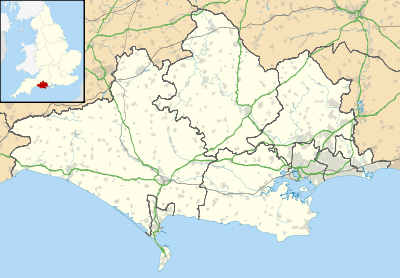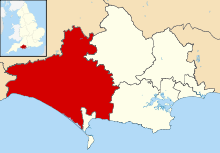Melbury Osmond
| Melbury Osmond | |
|---|---|
 Parish church of St Osmund | |
 Melbury Osmond Melbury Osmond shown within Dorset | |
| Population | 199 [1] |
| OS grid reference | ST574077 |
| District | |
| Shire county | |
| Region | |
| Country | England |
| Sovereign state | United Kingdom |
| Police | Dorset |
| Fire | Dorset and Wiltshire |
| Ambulance | South Western |
| EU Parliament | South West England |
Melbury Osmond is a village and civil parish in the county of Dorset in southern England. It lies in the West Dorset administrative district, about 7 miles (11 km) south of the Somerset town of Yeovil. The underlying geology is Cornbrash limestone, with adjacent Oxford clay.[2] Within the clay can be found deposits of stone which can take on a very high polish, earning them the name "Melbury marble".[3] The village is mentioned in the Domesday Book as a possession of the Arundell family, and remained so until the 19th century. The parish church, St. Osmund's, was totally rebuilt in 1745[4] and restored in 1888, although it has registers dating back to 1550. In the 2011 census the parish had a population of 199.[1]
The major part of Melbury Osmond village lies on a cul-de-sac lane which from the church descends past cottages to a stream and ford. The attractive appearance of the village has been noted by commentators: it has been described as "a calendarsmith's dream of thatched cottages"[5] and in 1906 Sir Frederick Treves wrote that it was "the most charming village in these Western backwoods".[4]
In its history the village has been involved in the trade of plated buckles and horn buttons, and the manufacture of dowlas.[4] During the 19th century, the village was home to the Dorset Ooser, a wooden mask brought out during "Rough Music" ceremonies.[6]
There are 34 listed buildings and structures within the parish, including the Grade II* Old Rectory and the Grade I parish church.[7]
Thomas Hardy's mother lived in Melbury Osmond as a child, and she was married in the church.[8] The village appears as "Little Hintock" in Hardy's novel The Woodlanders, in which the heroine's name is "Grace Melbury". Hardy also incorporated a legend about the Duke of Monmouth taking refuge in one of the village's cottages into his short story "The Duke's Reappearance".[8]
Notes
- 1 2 "Neighbourhood Statistics. Area: Melbury Osmond (Parish). Key Figures for 2011 Census: Key Statistics". Office for National Statistics. Retrieved 29 September 2013.
- ↑ Ralph Wightman (1983). Portrait of Dorset (4 ed.). Robert Hale Ltd. p. 18. ISBN 0 7090 0844 9.
- ↑ West Dorset District Council, Holiday and Tourist Guide, c.1983, p13
- 1 2 3 Treves, Sir F., Highways and Byways in Dorset, Macmillan, 1906, pp322-323
- ↑ Roland Gant (1980). Dorset Villages. Robert Hale Ltd. p. 104. ISBN 0 7091 8135 3.
- ↑ Dewar, H. S. L. (1962). "The Dorset Ooser". Proceedings of the Dorset Natural History and Archaeological Society. 84: 178&ndash, 180.
- ↑ "Listed Buildings in Melbury Osmond, Dorset, England". British Listed Buildings. Retrieved 10 July 2012.
- 1 2 Ken Ayres (October 2007). "Melbury Osmond". Dorset Life. Retrieved 29 September 2013.
External links
| Wikimedia Commons has media related to Melbury Osmond. |
